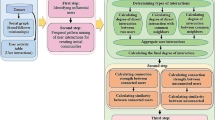Abstract
Social media plays a vital role in connecting people all around the world through various walks and phases of life, forming clustered meaningful communities. However, there is more scope for the social media platforms to mine fine-grained information that can entice and surprise the social media users based upon their respective egocentric networks. The list of mutual friends in an individual’s social network might be trivial or obvious most of the time. To up the game and surprise the individuals, the social media platforms could mine those mutual connections that are connected across different communities, serving as inter-cluster crucial edges between communities. As these connections are across the communities, the user possibly wouldn’t be aware of these connections and thus would be surprised to know them.
This work contributes along the lines of deploying community detection algorithms like Girvan Newman and graph based modelling techniques to produce the optimal number of surprise connections. This model was tested on real world Twitter based egocentric networks of 156 college students with evidence and survey, showcasing a good performance in surprising users,thereby increasing the interaction and engaging time of users on the social media platform significantly.
S. P. Mylavarapu and S. Govindarajan—Both the authors contributed equally to this work.
Access this chapter
Tax calculation will be finalised at checkout
Purchases are for personal use only
Similar content being viewed by others
References
Hogan, B.: Visualizing and interpreting facebook networks. In: Analyzing Social Media Networks with NodeXL, Insights from a Connected World. Amsterdam, Elsevier, pp. 165–179 (2011) https://doi.org/10.1016/B978-0-12-382229-1.00011-4
“API Reference.” API Reference-Tweepy 3.5.0 Documentation. Retrieved from https://docs.tweepy.org/en/v3.5.0/api.html
“Docs-Twitter Developers”. Retrieved from https://developer.twitter.com/en/docs.html
Girvan, M., Newman, M.E.J.: Community structure in social and biological networks. Proc. Natl. Acad. Sci. 99(12), 7821–7826 (2002)
Qi, X., Song, H., Wu, J., Fuller, E., Luo, R., Zhang, C.Q.: Eb&D: a new clustering approach for signed social networks based on both edge-betweenness centrality and density of subgraphs. Elsevier Phys. A. Stat. Mech. Appl. 482, 147–157 (2017)
Newman, M.E.J., Girvan, M.: Finding and evaluating community structure in networks. Physical Review E, USA, American Physical Society. 69 26–113 (2004)
Newman, M.E.J.: Fast algorithm for detecting community structure in networks. In: Physical Review E, USA, American Physical Society. 69, 66–133(2004)
Newman, M.E.J.: Finding community structure in networks using the eigenvectors of matrices. Physical Review E, USA, American Physical Society. 74(3), 36–104 (2006)
Hagberg, A., Swart, P., S Chult, D.: Exploring network structure, dynamics, and function using NetworkX. In Gäel Varoquaux, Travis Vaught, and Jarrod Millman (Eds), Proceedings of the 7th Python in Science Conference (SciPy2008). Pasadena, CA USA, pp 11–15 (2008)
Liu, D., Wang, C., **g, Y.: Estimating the optimal number of communities by cluster analysis. Int. J. Modern Phys. B, 30, p. 1650037 (2016)
Author information
Authors and Affiliations
Corresponding author
Editor information
Editors and Affiliations
Rights and permissions
Copyright information
© 2020 Springer Nature Singapore Pte Ltd.
About this paper
Cite this paper
Mylavarapu, S.P., Govindarajan, S. (2020). IDK My Friends: Link Analysis on Social Networks to Mine Surprise Connections. In: Balusamy, S., Dudin, A.N., Graña, M., Mohideen, A.K., Sreelaja, N.K., Malar, B. (eds) Computational Intelligence, Cyber Security and Computational Models. Models and Techniques for Intelligent Systems and Automation. ICC3 2019. Communications in Computer and Information Science, vol 1213. Springer, Singapore. https://doi.org/10.1007/978-981-15-9700-8_3
Download citation
DOI: https://doi.org/10.1007/978-981-15-9700-8_3
Published:
Publisher Name: Springer, Singapore
Print ISBN: 978-981-15-9699-5
Online ISBN: 978-981-15-9700-8
eBook Packages: Computer ScienceComputer Science (R0)




